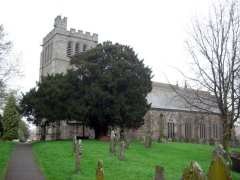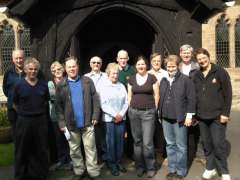2009 Hereford Ringing Course
Sometime in the last year or two I became aware that there are courses to help one learn to ring. After reaching a level of comfort ringing Plain Bob Doubles, mastering it would be too bold a claim, I had to decide what to learn next. I opted for Grandsire Doubles since it is widely rung and is quite different to Plain Bob Doubles.
In January I mentioned to the folks at Pershore that have been helping me that I was considering applying for this year's Hereford Ringing Course and it was suggested that I sign up for Plain Bob Minor rather than Grandsire Doubles. I followed this advice, applied and was accepted. I carried on learning Grandsire Doubles until early April and then for a couple of weeks rang some Plain Courses of Plain Bob Minor on each bell to familiarise myself before attending the course. While there were the anticipated similarities between Plain Bob Doubles and Plain Bob Minor there are also significant differences!
I deliberately only lightly prepared myself before the course so as not to arrive with too many bad habits or preconceptions.
2009-04-16
This was to be the 47th Hereford Ringing Course and took place at The Royal National College for the Blind (RNC) in Hereford.
The course starts on Thursday evening and registration is open from 16:00. We had the agenda in advance so registration was simply a matter of collecting a room key, a badge and a couple of supplementary pages with a map of the RNC and some housekeeping notes.
The first gathering is at 19:00 for a brief welcome by the Master of the Hereford Diocesan Guild followed by an introduction to the course. This was all handled quickly and off I went to meet my Bob Minor group, labelled FG. The group consisted of 3 other students, Felicity from Kent, a man from Dorset and Shelagh who I already knew as she is from my neck of the woods. We also met our tutor and several helpers. The main purpose of this gathering was to arrange transport to our first practical session. We were a mixed practical group with 4 of us doing Plain Bob Minor and 2 learning Kent Treble Bob Minor. I was happy to drive and took Shelagh, Felicity and Thelma from the Kent Treble Bob Minor group as passengers.
Our first minor wrinkle was that we had to hold our first meeting in the corridor as our meeting room (C10) was locked.
Practical session - Kingsland
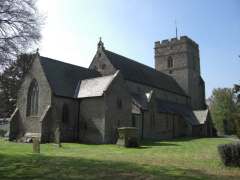
St Michael & All Angels,
Kingsland
Our first practical session was scheduled to take place at St Michael & All Angels in Kingsland, a village about 13 miles North of RNC. The weather is poor and it was dark when we arrived but Felicity, my navigator, did an excellent job getting us there. There is plenty of room to park on the North side of the church.
This is a pretty big church with a large tower and a ringing room that is reached by climbing a stone spiral staircase. The start of the staircase is inside the church. The ringing room is large, plenty of space for all of us. While there are 8 bells, we would only use the back 6. I only rang bell #3 of the back six and that went very smoothly.
The objective of this practical was to allow our tutor to gauge our competence. We each chose what we would like to ring and then performed with 5 of the helpers accompanying us. I do recall that Felicity chose to ring Plain Bob Doubles which she rang faultlessly. I chose to ring Plain Courses of Plain Bob Minor which effectively demonstrated the difficulty I was encountering dealing with the new work of dodging 5-6 up and down. I think the others also chose to ring whatever it was that they have come to learn.
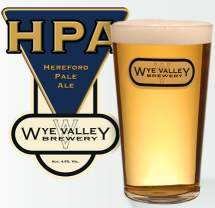 That done we all headed back to RNC and met in the Main Hall for a relax and a drink. My passengers treated me to some pleasant real ale,
HPA.
That done we all headed back to RNC and met in the Main Hall for a relax and a drink. My passengers treated me to some pleasant real ale,
HPA.
Next wrinkle, the queue for HPA was long and slow moving. They really could not keep up with the demand. This seems to reinforce my previous experience that Bell Ringers like real ale.
This became a pattern for the rest of the course, I would drive, I'm not a very happy passenger at the best of times, and I would be repaid in beer. From my perspective this was an excellent arrangement!
2009-04-17
This is Friday and our first real day, breakfast is served at 08:00 for those that can bear to eat at this time of day.
Lecture
The first lecture/discussion starts at 09:00. Our course tutor gives us feedback that, based on what he saw in the practical, we are all suitably skilled to be on the Plain Bob Minor course. Each of us then discusses where we think we are, what problems we have and what we would like to achieve by the end of the course. In summary, we would all like to be able to ring a Touch. Quite what theory we did in each session now escapes me but I think that we covered what happens in a Plain Course and some of the signposts. The course bell, the after bell and passing the treble and why the 5-6 dodges might be giving me trouble. Tea/coffee then off for another practical.
Madley
Everyone seemed happy to adopt the same travel arrangements as before and we set off for Nativity of the Blessed Virgin Mary in Madley. This didn't go quite so well, there was traffic congestion in Hereford due to construction so we chose to take a more westerly river crossing. We arrived at the tower on time but we did go a somewhat circuitous route due to new roads that were not on my 5 year old map.
This was another large 8 bell tower. Parking was more problematic though we all managed to find a space reasonably nearby.
We all rang for two sessions. My first session I rang a couple of Plain Courses on bell #3 so that I could compare it with last nights effort. The first course went ok and the second went well with apparently no error and only a couple of minor blips with striking. For my next go I chose to do a couple of plain courses on bell #5. This was also mostly ok though some hesitation on the 3-4 up dodge. I need to trust my rhythm, particularly when getting close to the lead.
Overall I was pretty happy with the mornings ringing and I got the sense that this was also the case for my fellow pupils.
Back to RNC for lunch.
Lectures
We start the afternoon at 13:50. The weekend includes a number of general lectures that are not connected to the main thread of chosen method. These had to be chosen when registering for the course. I chose "Calling/conducting Bob Doubles". There were about a dozen students and we were told several ways in which we could call a Touch of Plain Bob Doubles. The one I was most familiar with is calling when you, the conductor, are the Observation bell. The other ways seemed to be variations on the In, Out Make (the bob) scheme that I had heard of but never understood.
Wrinkle 3: . . . 10 students were waiting patiently in our assigned room when after 10minutes we concluded that since the lecturer had not turned up something had gone awry. Someone volunteered to go try and find out what had happened. He came back 5 minutes later to tell us that the lecture was taking place elsewhere and had proceeded with the two students who had somehow ended up in the same room as the lecturer. Seems the lecturers instructions differed from those posted for students.
A cup of tea then back with our Plain Bob Minor team for some more discussion and theory. The topic is "Touches". I think we had all taken a look at the effect of bobs and singles before we came but this was a good session. We received a thorough review of not only what by why and how. We were also introduced to the significance of place bells. This was a term I'd heard but never understood and at this point I was intrigued but didn't understand all of their significance and usage.
Bromyard
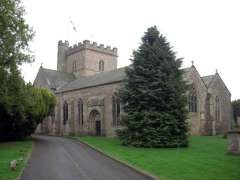
St Peter,
Bromyard
Time to put some of the newly learned theory in to practice. So it is off to St Peter for another practical session. Bromyard is a small town 13 miles North-east of RNC so we do not have to cross the river. It is an easy journey and we arrive in plenty of time. There is plenty of parking beside the church which is on Church Lane in the East of the town.
Another large church with a spacious 8 bell tower. The entrance to the stone spiral staircase that leads of to the ringing room is inside the tower.
We followed the usual format with each of us ringing what we wanted. I started with a plain course of Bob Minor which went quite well and followed it by several courses interspersed with bobs. This went fairly well but as time went by I was starting to lose confidence but we stopped before I fell apart.
Another good practice where I felt that I had made some valuable progress.
Hampton Bishop
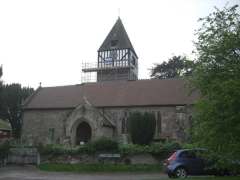
St Andrew,
Hampton Bishop
For the Friday evening it seems that, for some irrational reason, I had signed up for "Conducting practicals". This was to take place at St Andrew, Hampton Bishop. Earlier in the day I actually realised what I'd done and had joked that I would simply ring the treble and call bob or single every time I was leading.
The village is about 4 miles South-east of RNC and most of the drive is through Hereford suburbs. There is not much parking nearby but I managed to find a space. The church was quite different to all the ones we had yet visited, it was a ground floor ring with the tower on the North side of the church. The ringing area has two stone walls and the two sides looking onto the nave are enclosed in glass. A rather nice setup. However, the bells are not so nice to ring. It is a long pull without any rope guides and those that had rung there before warned us that while recent work had been done to improve them they were still tricky. I rang up bell #5 which seemed ok. It seems that I was not the only student reluctant to conduct and I was persuaded to have a go.
It would have been sheer madness to try and call Bob Minor so I decided to have a go at calling Bob Doubles. I chose bell #3 and planned on the simplest approach of calling myself as observation. It suddenly dawned on me that I could not recollect ever ringing a touch of Bob Doubles as observation! So I am faced with three problems, ringing tricky bells, ringing observation for the first time and calling a touch for the first time.
Oh well, in for a penny, in for a pound. I was amazed when in no time at all I had to say "that's all". I'd concentrated so much on calling that the ringing and method just happened and it was all over. I was rather pleased. I watched another student call Bob Minor and was asked if I wanted another go. I was a bit reluctant to take the chance of falling of my perch but figured I'll have to do it again one day so decided to have another go. The lady ringing the treble suggested that I could call the bob a smidgen earlier but it all worked, again. Finally, I was asked if I would like to call another with someone else as observation, but I opted to watch someone rather than do it myself. Perhaps if we hadn't run out of time I would have had a go.
In the end, the evening that I was in two minds about turned out to be most satisfying!
Down time
Back to RNC for a relaxing beer, or two, and pleasant conversation.
2009-04-18
Lecture
It is Saturday morning already and we start at 09:00. We meet with our group tutor for some feedback and discussion on yesterday's activity. We have already covered all the theory required for Bob Minor so we spend the time looking at the future and we are given some guidance on how to go about learning new methods.
As we progress we will spend less time plain hunting and more time working. We were introduced to a number of new terms including: Lead End, Half Lead, Place Notation, Place bell, Place bell order, Coursing order. The earlier discussion on Place bell had intrigued me and after this subsequent discussion I think that it is something that I need to invest time in before I start a new method.
Tea/coffee then off for another practical.
Staunton on Arrow
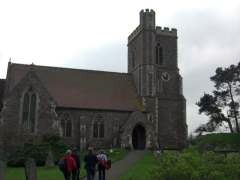
St Peter,
Staunton on Arrow
Our first practical of the day is at St Peter, Staunton on Arrow, not Staunton on Wye which is where some of our party went before realising their error. This is a good half hour drive, about 20 miles, from RNC. Parking is limited.
You enter a door in the outside of the tower and climb a stone spiral staircase to the ringing room. This is the smallest tower we have visited but there was room for all of us without being in the way of those ringing the 6 bells. I rang up bell #5 of what was, by a long way, the lightest set of bells we had rung so far. Light bells gave us something else to adapt to.
I chose to ring bell #3, same as yesterday, which may have been a mistake. I chose to tackle the one remaining feature of Bob Minor that was untried, i.e. singles. No sooner had I started ringing and I had to stop, the rope was far too long and I had to shorten it. An inauspicious start. I rang a touch with 6 singles and was shocked when the first one was called. I had focussed so much concentration on the new work, i.e. reverse thirds that I had forgotten about the other bell affected at a single, luckily the first one was called when I was making 2nds so I was unaffected. Phew! In the end I got through it OKish. My main problem was going out to the back after making reverse thirds.
Second attempt went a bit better.
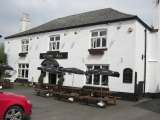
Crown Inn, Dilwyn
I was glad that we didn't have to go all the way back to RNC again for a lecture before visiting our afternoon practical. Our afternoon ring was only about 7 miles away in Dilwyn.
A booking for lunch had been made at the Crown Inn in Dilwyn. It is only a short stroll from the pub to St Mary The Virgin Church where we were to ring in the afternoon.
The weather was at last starting to brighten up so we chose to eat a pleasant, reasonably priced, meal in the garden.
Dilwyn
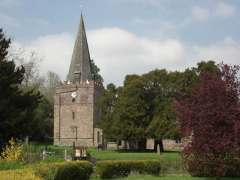
St Mary The Virgin,
Dilwyn
St Mary The Virgin, Dilwyn is beside what looks like the old A4112 before the bypass was built. We left our cars in the pub car park while we rang so I am not sure what parking arrangements there may be.
The ringing room is reached by climbing a steep stair/ladder from inside the tower. Only 6 bells again but nice to ring. After my morning experience I chose to ring up the bell I'd use later, i.e. bell #3.
For my first touch I decided to put it all together, bobs and singles in whatever combination our tutor cared to call. I was not happy with the experience, though I did make it though with help. Bizarrely, the problems were not with the bobs and singles I had regressed and was having trouble seeing the 5-6 dodges. I think I was getting tired.
When it came to my second touch I felt clearer headed and it did go much better. I really felt happy with the reverse thirds. I did have two glitches but I knew I'd made them and my guide helped me recover.
Strange as it may sound, we had been warned that people often suffer difficulties during the Saturday afternoon sessions. It certainly got to me! I'm glad the second attempt went better.
Leominster
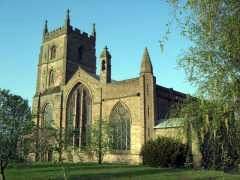
St Peter & St Paul,
Leominster
Saturday evening was another choice I had made when I registered. I opted to join general ringing at St Peter & St Paul, Leominster.
Leominster is only 10 miles North of RNC along the A49. While the ringing was not due to start until 19:30 I went up early to a look around. I haven't been to Leominster for years and should have known that everywhere would be closed. I ate my picnic in the park at the park on the South side of the churchyard. While churchyard was attractive there were no benches.
The ringing room is reached by climbing a stone spiral staircase. There is a small door on the North side of the tower that gives access.
I do not know any methods for 10 bells but rang Bell #9 twice for Plain Hunt on 9 and Rounds & Call Changes. I also rang the same on bell #7. They were a delight to ring.
A variety of methods were rung but when they said they would do Plain Bob Royal I decided to observe bell #3 to see how it build on what I've been learning for Bob Minor. I stood behind the lady ringing bell #3 and off they went, just as she was about to lead a bob was called, so Plain Hunt again. . . unfortunately the touch being called meant that this happened every time. She had to plain hunt the entire touch!
Later on they declared that they would ring a plain course of Plain Bob Royal and this time I did get to observe another lady and managed to follow the work. I'm optimistic that scaling up to Bob Major and Bob Royal should not be beyond me once I am confident with Bob Minor.
The only other alternative that had appealed to me for this session was a visit to Hereford Cathedral but reasoned that a lot of people might opt for that choice. Subsequently I heard that ringing at the Cathedral is tricky and it turns out that a lot of people had indeed opted to go so my decision turned out to be a good one.
Social
Back at RNC it is our final social gathering and there were a lot of people there. There was a great ambience with several musicians playing music, the buzz of conversation and consumption of HPA. Most of us stayed until after the bar closed at midnight. A very enjoyable evening.
Wrinkle. If I thought the queue for HPA was long and slow moving on Thursday, tonights proved that it could be much worse!
2009-04-19
Sunday is our last day of the course. Only the final practical session will be on Bob Minor. We have to be out of our rooms and hand our keys in by 10:00.
Lectures
For the 090:00 session I chose the session "Doubles methods beyond Plain Bob". It used Plain Bob Doubles and Grandsire Doubles as the basis to describe Doubles methods then went on to describe a number of Doubles methods that are widely rung. I had encountered several of them and it was interesting to compare and contrast them and to see how blocks of work are combined.
10:00 Coffee
The last lecture was entitled "Making your own method". This introduced the construction of a Minor method. It defined a series of constraints that need to be satisfied and then we worked through creating a couple of methods. This session complemented nicely some of the work from our own tutor session on Saturday since it dealt with Lead End, Half Lead and Place Notation.
All done at RNC I went to nearby Morrisons Supermarket to get something for lunch. The weather was finally warm and sunny so a picnic near our afternoon location seemed like a good idea.
Final Wrinkle. This time my fault. When I came to pay in Morrisons I found my room key in my pocket, oops. I was not, understandably, very popular when I returned to RNC at about midday to drop of my key.
Burghill
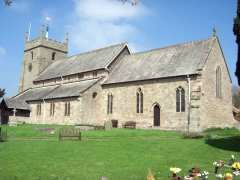
St Mary the Virgin,
Burghill
Our final practical session was at St Mary the Virgin, Burghill which is only about 4 miles from RNC. There is parking at the East side of the churchyard but be careful to avoid the spot reserved for the organist. There is a lovely, well maintained churchyard with a number of benches. A quiet, peaceful spot to soak up some sunshine.
We didn't enter the main body of the church as there is a door in the West side of the tower. The ringing room is reached by climbing a wrought iron spiral staircase. The room was a little tight for so many but the 8 bells were nice to ring.
For my last practical a touch of Bob Minor lasting about 10 minutes with everything included. I made two mistakes. The first was to "make the bob" and forget what to do next, my helper put me right. The second was when a bob was called as I was doing 3-4 down I started to do the work of a single but once again my ever vigilant helper put me straight. I still felt wobbly when doing some of the 5-6 dodges but I was told that I had done then correctly so my rhythm must have been keeping me on the straight and narrow.
And that was it, a few more photos, exchange of emails and it was time to go home.
Note: For anyone organising a trip here, there is a toilet.
Afterword
And finally a few final thoughts, the most important being that I will go again.
The Good
The course was well organised. Our tutor was excellent, he was obviously skilled and able to impart his knowledge but he was also patient and a pleasure to spend time both during the course and in our free time. The group was small, just 4 of us learning Bob Minor. Having 6 helpers meant that we had a strong band around us while we were doing our practicals. Herefordshire is a lovely county and we rang at some nice venues with good bells.
All the towers we visited as part of the course are in Herefordshire and are associated with the Hereford Diocesan Guild of bellringers.
My fellow students, and others that I met at lectures or social gatherings were all great company.
The Bad
Nothing terrible to recount. A few wrinkles along the way but nothing that detracted from the pleasurable weekend.
